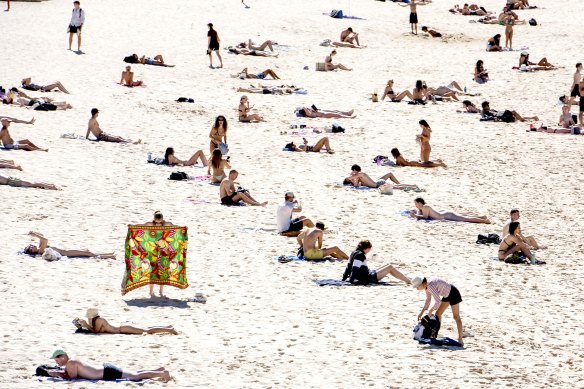Heat records tumbling as Sydney’s winter comes towards its end
By Nick O'Malley and William Davis
A build-up of heat across central Australia has sent temperatures soaring across the continent and breaking late winter records. Parts of Sydney are expected to reach 24 degrees on Monday – two to three degrees above average.
By midday in Sydney on Monday, the temperature had reached 21 degrees, with many heading to the city’s beaches.

Sun lovers on Coogee Beach.Credit: Steven Siewert
Inland records have been shattered as parts of southern Queensland, Western Australia and central Australia reach 10 to 12 degrees above average. In those areas, heat has been building underneath a high-pressure system and clear skies.
On Saturday, the hottest ever winter daytime temperature of 39.4 degrees was recorded at Oodnadatta in South Australia.
Since then, that heat has slowly shifted to the east coast. On Saturday at Bellambi, south of Sydney, the temperature reached 28.3 degrees.
By Monday morning, Brisbane was on track for its hottest winter day in more than a decade, and there are predictions that a record temperature could be set this weekend.
“To see the end of this heat, we really need a strong front pushing that heat away from the continent – a southerly flush for areas like the east coast of NSW, Queensland,” said Bureau of Meteorology senior meteorologist Miriam Bradbury.
She said there were strong indications this summer would be hotter than average.
The Brisbane temperature was tipped to hit 31 degrees by the end of the day before climbing to 32 degrees on Thursday and Friday and peaking at 34 degrees on Saturday.
As far south as Avalon airport, west of Melbourne, a late August record of 26.6 degrees was set, though by Monday afternoon the Bureau of Meteorology said damaging winds associated with a cold front could hit the state by Tuesday morning.

Having endured a wet winter, Sydneysiders enjoyed unseasonably warm weather on Monday. Credit: Steven Siewert
Professor Lesley Hughes, a director with the Climate Council, said this had been a particularly short and hot winter, and that global average temperature records had been broken every single month of the past year.
“We keep seeing tumbling records month after month after month. It is not normal to have a temperature of 40 degrees in South Australia in August,” she said.
“This represents a dangerous escalation of extreme heat.”
She said the high temperatures were further evidence Australian governments should focus more acutely on reducing greenhouse gas emissions and commit to no longer opening up new coal and gas fields.
Start the day with a summary of the day’s most important and interesting stories, analysis and insights. Sign up for our Morning Edition newsletter.